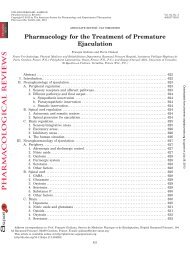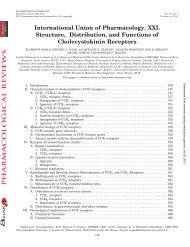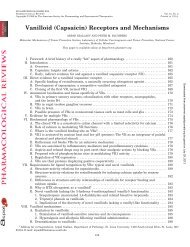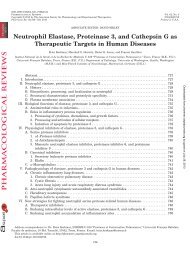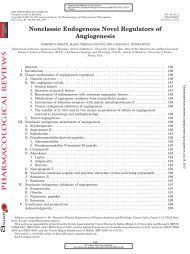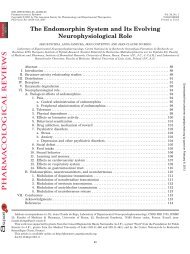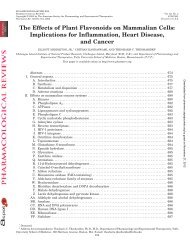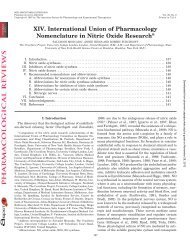Opioids, Reward and Addiction: An Encounter of Biology ...
Opioids, Reward and Addiction: An Encounter of Biology ...
Opioids, Reward and Addiction: An Encounter of Biology ...
You also want an ePaper? Increase the reach of your titles
YUMPU automatically turns print PDFs into web optimized ePapers that Google loves.
self-administration model can serve as a useful model for<br />
the prediction <strong>of</strong> the abuse potential <strong>of</strong> drugs in humans<br />
(Thompson <strong>and</strong> Young, 1978; Van Ree et al., 1978; Van<br />
Ree, 1979; Collins et al., 1984).<br />
Intravenous self-administration in rats <strong>and</strong> monkeys<br />
is the most frequently used to assess the reinforcing<br />
effects <strong>of</strong> drugs. However, other models using other species<br />
(e.g., dogs, cats, mice, or pigeons) or other routes <strong>of</strong><br />
administration (e.g., intragastric, oral, inhalation, i.c.v.,<br />
or intracerebral) have been developed (e.g., Smith et al.,<br />
1976; Jones <strong>and</strong> Prada, 1977; Carroll <strong>and</strong> Meisch, 1978;<br />
Van Ree <strong>and</strong> Niesink, 1978; Van Ree et al., 1979; Kilbey<br />
<strong>and</strong> Ellinwood, 1980; Van Ree <strong>and</strong> De Wied, 1980;<br />
Bozarth <strong>and</strong> Wise, 1981b; Criswell, 1982; France et al.,<br />
1991; Mattox <strong>and</strong> Carroll, 1996).<br />
Although the positive reinforcing effects <strong>of</strong> a drug are<br />
the most important stimuli in self-administration behavior,<br />
other factors may contribute significantly to operant<br />
behavior <strong>and</strong> thus self-administration behavior. These factors<br />
include, among others, conditioned or secondary reinforcement<br />
<strong>and</strong> negative reinforcement. Distinctive, neutral<br />
environmental stimuli that are repeatedly associated with<br />
the primary reinforcing effects <strong>of</strong> a drug, can acquire (secondary)<br />
reinforcing properties through classical conditioning<br />
(Davis <strong>and</strong> Smith, 1976; Beninger, 1983; Stewart et al.,<br />
1984). These stimuli are then called conditioned or secondary<br />
reinforcers. Although the primary reinforcing effects<br />
<strong>of</strong> the drug mainly determine the initiation <strong>of</strong> selfadministration<br />
behavior, the conditioned or secondary reinforcers<br />
maintain this behavior over time, even in the<br />
absence <strong>of</strong> the primary reinforcer. For example, a red light<br />
switched on when a monkey presses a lever to obtain a<br />
morphine injection subsequently supports lever-pressing<br />
when morphine is temporarily not available (Schuster <strong>and</strong><br />
Woods, 1968). The effects <strong>of</strong> conditioned reinforcers diminish<br />
over time when the drug injection is no longer available.<br />
In animals made physically dependent on drugs, an<br />
additional factor influencing self-administration behavior<br />
is exerted by negative reinforcement, i.e., the animals will<br />
continue to self-administer a drug to alleviate or overcome<br />
the presumably aversive (negative) state <strong>of</strong> withdrawal<br />
(Solomon, 1980; Koob et al., 1989a).<br />
B. Intracranial Electrical Self-Stimulation<br />
Intracranial electrical self-stimulation (ICSS) is<br />
widely used to explore the involvement <strong>of</strong> particular<br />
brain circuits in reward. Typically, when an animal is<br />
equipped with an electrode placed in a “positive” brain<br />
area <strong>and</strong> given the opportunity to perform a behavioral<br />
response, e.g., pressing a lever, that is followed by a<br />
short-pulse train <strong>of</strong> electrical current via the electrode,<br />
the animal will initiate <strong>and</strong> maintain responding. Thus,<br />
the stimulation serves as an operant reinforcer (Skinner,<br />
1938). The phenomenon <strong>of</strong> ICSS has been described<br />
initially by Olds <strong>and</strong> Milner (1954), who observed this<br />
behavioral pattern in rats equipped with electrodes in<br />
the septal area <strong>of</strong> the brain. ICSS was suggested to be<br />
OPIOIDS, REWARD AND ADDICTION 347<br />
linked to brain circuits implicated in natural incentives<br />
such as food <strong>and</strong> sexual contact (Olds <strong>and</strong> Milner, 1954;<br />
Trowill et al., 1969; Mogenson <strong>and</strong> Wu, 1982). However,<br />
it appeared that a variety <strong>of</strong> brain structures, related<br />
<strong>and</strong> not related to natural incentives, could support<br />
ICSS (Olds et al., 1971; Wise, 1996). Although ICSS<br />
resembles other types <strong>of</strong> reward, it has some unique<br />
properties. In most stimulated sites, the rewards are<br />
strong <strong>and</strong> immediately present during stimulation <strong>and</strong><br />
it lasts not much longer than the stimulus itself. The<br />
brain structures in which ICSS can be elicited have been<br />
designated as reward or pleasure centers. Whether<br />
these various brain structures belong to a single system<br />
or to multiple reward circuits operating in parallel is<br />
still a matter <strong>of</strong> debate.<br />
In general, drugs <strong>of</strong> abuse facilitate ICSS in that the<br />
frequency current-response function is shifted leftward<br />
in a parallel manner <strong>and</strong>/or the threshold for eliciting<br />
ICSS is decreased. Such findings have been documented<br />
for morphine <strong>and</strong> heroin (Esposito <strong>and</strong> Kornetsky, 1977;<br />
Van Wolfswinkel <strong>and</strong> Van Ree, 1985b; Hubner <strong>and</strong> Kornetsky,<br />
1992; Bauco et al., 1993), amphetamines (Gallistel<br />
<strong>and</strong> Karras, 1984; Schaefer <strong>and</strong> Michael, 1988b),<br />
cocaine (Bain <strong>and</strong> Kornetsky, 1987; Frank et al., 1988;<br />
Van Wolfswinkel et al., 1988; Bauco <strong>and</strong> Wise, 1997),<br />
nicotine (Huston-Lyons et al., 1992; Bauco <strong>and</strong> Wise,<br />
1994; Ivanova <strong>and</strong> Greenshaw, 1997; Wise et al., 1998),<br />
phencyclidine (Kornetsky <strong>and</strong> Esposito, 1979; Carlezon<br />
<strong>and</strong> Wise, 1993b), <strong>and</strong> 9 -tetrahydrocannabinol (Gardner<br />
et al., 1988, 1989; Lepore et al., 1996). With respect<br />
to ethanol, the data so far are not fully consistent (De<br />
Witte <strong>and</strong> Bada, 1983; Schaefer <strong>and</strong> Michael, 1987; Bain<br />
<strong>and</strong> Kornetsky, 1989, Moolten <strong>and</strong> Kornetsky, 1990;<br />
Lewis <strong>and</strong> June, 1994). It seems that facilitation <strong>of</strong> ICSS<br />
is an effect that drugs <strong>of</strong> abuse have in common, despite<br />
the differential pharmacological characteristics <strong>of</strong> these<br />
drugs. Thus, facilitation <strong>of</strong> ICSS may be relevant for the<br />
dependence-creating properties <strong>of</strong> drugs <strong>and</strong> worthwhile<br />
to analyze in detail to underst<strong>and</strong> the basic mechanisms<br />
<strong>of</strong> drug dependence.<br />
Concerning the neurobiology <strong>of</strong> ICSS, catecholamines<br />
<strong>and</strong> especially DA have been implicated as important<br />
neurotransmitters in the reward circuit (Crow, 1972;<br />
German <strong>and</strong> Bowden, 1974; Wise, 1978). Evidence that<br />
DA is involved in ICSS stems from anatomical studies<br />
(Corbett <strong>and</strong> Wise, 1980), lesion experiments (Fibiger et<br />
al., 1987), pharmacological manipulations (Zarevics <strong>and</strong><br />
Setler, 1979; Wise <strong>and</strong> Rompré, 1989), <strong>and</strong> neurochemical<br />
studies (Nakahara et al., 1992; Fiorino et al., 1993;<br />
Di Chiara, 1995). It has been suggested that in particular<br />
the mesocorticolimbic DA system is important for<br />
ICSS.<br />
C. Conditioned Place Preference<br />
Affective (rewarding or punishing) stimuli can evoke<br />
approach or avoidance behavior, respectively (Schneirla,<br />
1959). When these stimuli are paired with a neutral



